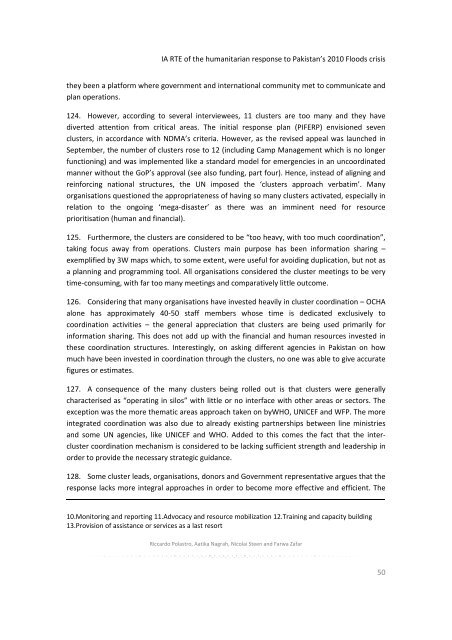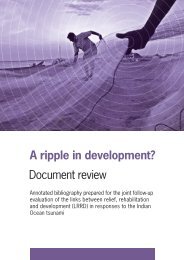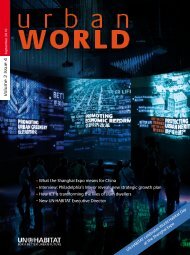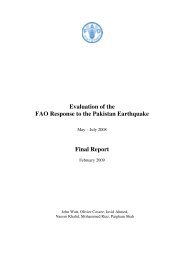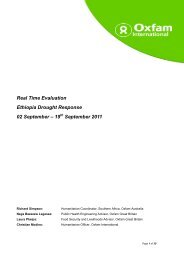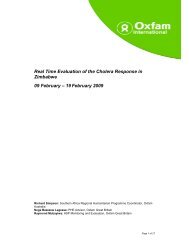Inter-Agency Real Time Evaluation of the Humanitarian ... - alnap
Inter-Agency Real Time Evaluation of the Humanitarian ... - alnap
Inter-Agency Real Time Evaluation of the Humanitarian ... - alnap
You also want an ePaper? Increase the reach of your titles
YUMPU automatically turns print PDFs into web optimized ePapers that Google loves.
IA RTE <strong>of</strong> <strong>the</strong> humanitarian response to Pakistan’s 2010 Floods crisis<br />
<strong>the</strong>y been a platform where government and international community met to communicate and<br />
plan operations.<br />
124. However, according to several interviewees, 11 clusters are too many and <strong>the</strong>y have<br />
diverted attention from critical areas. The initial response plan (PIFERP) envisioned seven<br />
clusters, in accordance with NDMA’s criteria. However, as <strong>the</strong> revised appeal was launched in<br />
September, <strong>the</strong> number <strong>of</strong> clusters rose to 12 (including Camp Management which is no longer<br />
functioning) and was implemented like a standard model for emergencies in an uncoordinated<br />
manner without <strong>the</strong> GoP’s approval (see also funding, part four). Hence, instead <strong>of</strong> aligning and<br />
reinforcing national structures, <strong>the</strong> UN imposed <strong>the</strong> ‘clusters approach verbatim’. Many<br />
organisations questioned <strong>the</strong> appropriateness <strong>of</strong> having so many clusters activated, especially in<br />
relation to <strong>the</strong> ongoing ‘mega‐disaster’ as <strong>the</strong>re was an imminent need for resource<br />
prioritisation (human and financial).<br />
125. Fur<strong>the</strong>rmore, <strong>the</strong> clusters are considered to be “too heavy, with too much coordination”,<br />
taking focus away from operations. Clusters main purpose has been information sharing –<br />
exemplified by 3W maps which, to some extent, were useful for avoiding duplication, but not as<br />
a planning and programming tool. All organisations considered <strong>the</strong> cluster meetings to be very<br />
time‐consuming, with far too many meetings and comparatively little outcome.<br />
126. Considering that many organisations have invested heavily in cluster coordination – OCHA<br />
alone has approximately 40‐50 staff members whose time is dedicated exclusively to<br />
coordination activities – <strong>the</strong> general appreciation that clusters are being used primarily for<br />
information sharing. This does not add up with <strong>the</strong> financial and human resources invested in<br />
<strong>the</strong>se coordination structures. <strong>Inter</strong>estingly, on asking different agencies in Pakistan on how<br />
much have been invested in coordination through <strong>the</strong> clusters, no one was able to give accurate<br />
figures or estimates.<br />
127. A consequence <strong>of</strong> <strong>the</strong> many clusters being rolled out is that clusters were generally<br />
characterised as “operating in silos” with little or no interface with o<strong>the</strong>r areas or sectors. The<br />
exception was <strong>the</strong> more <strong>the</strong>matic areas approach taken on byWHO, UNICEF and WFP. The more<br />
integrated coordination was also due to already existing partnerships between line ministries<br />
and some UN agencies, like UNICEF and WHO. Added to this comes <strong>the</strong> fact that <strong>the</strong> inter‐<br />
cluster coordination mechanism is considered to be lacking sufficient strength and leadership in<br />
order to provide <strong>the</strong> necessary strategic guidance.<br />
128. Some cluster leads, organisations, donors and Government representative argues that <strong>the</strong><br />
response lacks more integral approaches in order to become more effective and efficient. The<br />
10.Monitoring and reporting 11.Advocacy and resource mobilization 12.Training and capacity building<br />
13.Provision <strong>of</strong> assistance or services as a last resort<br />
Riccardo Polastro, Aatika Nagrah, Nicolai Steen and Farwa Zafar<br />
50


